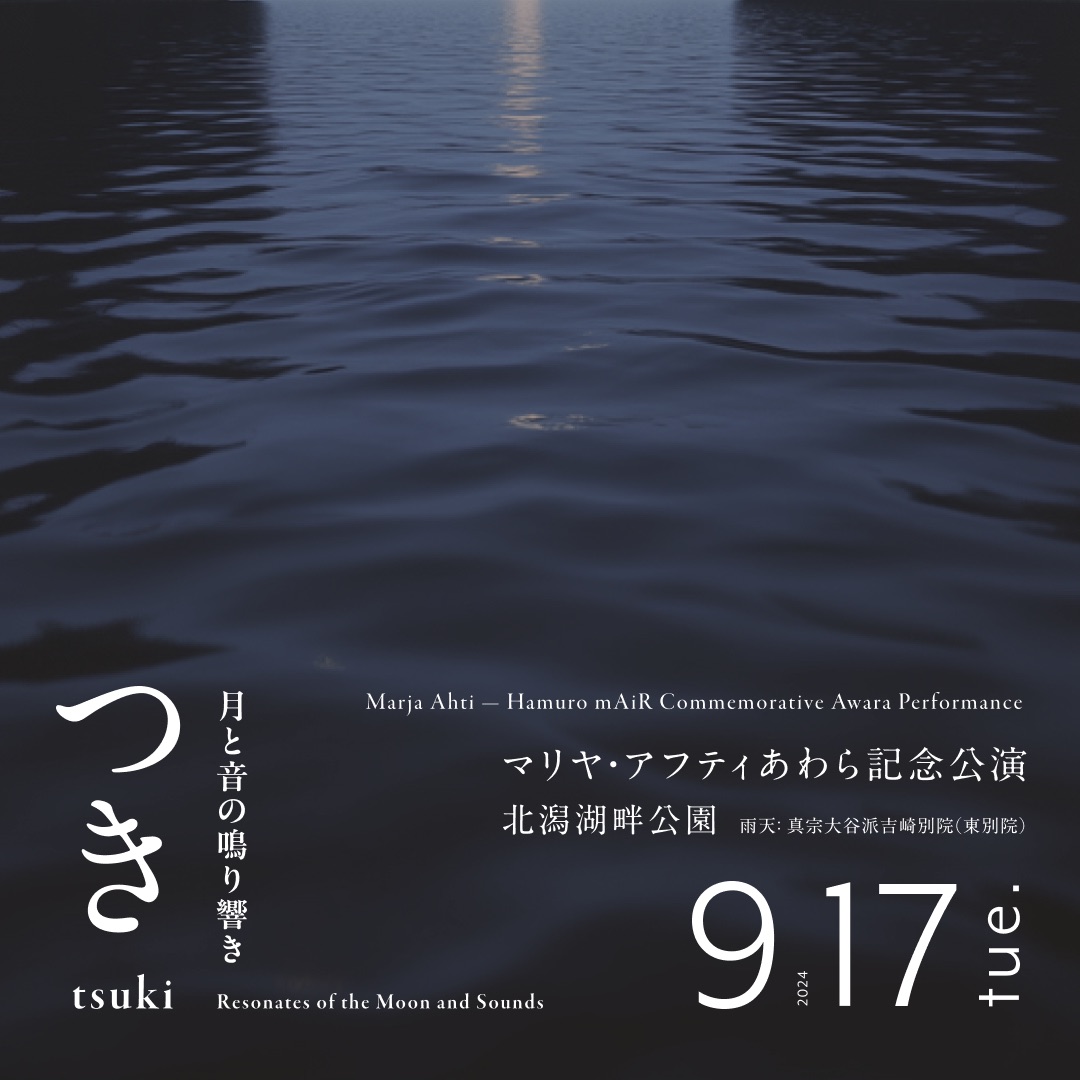
つき — 月と音の鳴り響き
マリヤ・アフティあわら記念公演
Marja Ahti — Hamuro mAiR Commemorative Awara Performance
※本イベントは終了しています。
空に輝き、湖面に揺れる「月」と、
世界を搗(つ)き、造りだす「サウンド・アート」の共演。
「闇」を切り開き
「新しい感覚」へいざなう。
「内なる力」を引き出し、
まだ見ぬ世界へ「思い」を広げる。
中秋の名月の夜を湖畔で楽しむ、
格別な芸術鑑賞/お月見イベントを開催いたします。
The mid-autumn moon (tsuki) – shining in the sky and swaying on the lake – will meet the art of sounds,
pounding (tsuki) and creating the world.
Cutting through the darkness and springing up new sensations.
Bring out your inner strength, expand your minds to a yet unseen world.
~–~–~–~–~
Set by the edge of a lake, tsuki is an exquisite event that combines the tradition of harvest moon-viewing and contemporary sound art.
日時
2024年9月17日火曜日
18:30 開場
19:00 開演
20:30 終演予定
会場
北潟湖畔公園
アクセス・会場案内
雨天:真宗大谷派吉崎別院(東別院)
※天候不良時は当日のお昼に本ページおよびインスタグラムにて会場をお知らせします。
出演
Marja Ahti(マリヤ・アフティ)
フィンランドの古都トゥルクを拠点に国際的に活躍するスウェーデン人の作曲家/サウンド・アーティスト。フィールドレコーディングやアコースティックな素材を使い、シンセサイザーや電子フィードバックと組み合わせることで、一つ一つの「音」同士がコミュニケーションが始める「場」を立ち上がらせる。そのように作られるアフティの音響作品はゆっくりと変調する「ハーモニー」と変異する「質感」が生み出す「波」に揺られており、荒さも含む、細部の豊かさが精密に織り込まれている。今回、ハムロ・マイクロ・レジデンシーのレジデンツとして福井には初の訪問となる。
松村忠尚+吉川武範
松村忠尚:福井県坂井市在住のサウンドクリエイター。舞台から広告まで幅広い領域で音楽を制作し、奏者としてもプロアマ問わず多くのアーティストと共演している。吉川武範:東洋的考えでドーシャや、身体、空間、さまざまな角度からクリスタルボウルの倍音で体へコンタクト。時には色々な音とセッションし音と音の共鳴の実験もしている。
座席・料金
- 座席のご用意はありません。必要に応じてイスやシートなどをご持参ください。
- 公演は無料で鑑賞いただけます。
- 終演時に出演者に対する Tipping(寄贈金)を受け付けます。
- このイベントは非営利団体と皆様のご協力で成り立つ文化事業のため、任意の金額で皆様のお心遣いをお願いいたします。
アクセス・会場案内
- 駐車場は北潟湖畔公園 駐車場(サイクリングパークの近く)または北潟多目的駐車場(道を挟んで「あわら北潟温泉hanaゆらり」の向かい)をご利用ください。
- 夜間で周辺は暗くなっています。足元等に十分お気をつけてご来場ください。
注意事項 ※必ずお読みください
ご来場いただいたすべての方が安全に楽しんでいただくために、以下の項目のご確認をお願いします。
- 未成年の方は必ず保護者同伴でご来場ください。また、保護者の方は必ずお子様にお付き添いください。
- 迷惑行為・危険行為はおやめください。
- 喫煙はおやめください。また、演奏中の飲食はお控えください。
- ゴミはお持ち帰りください。
- そのほか公園の利用ルールを守ってください。
開催概要
月は世界にたった一つ。
にもかかわらず、あらゆるものを照らし、そして、あらゆる月として昔から詠われ、描かれ、映され、そして愛でられてきた月。特に満月はひときわ鮮烈な情景をみせ、同時に、精神的な象徴として見られてきました。
「吾が心 秋月に似たり 碧潭清うして 皎潔たり」
碧潭(へきたん=青々とした深い湖のふち)
皎潔(こうけつ=清らかなこと)
これは、自分の澄み切った心境を、「青く澄んだ水面に映った中秋の名月」にたとえた、唐時代の僧、寒山の一句。
日本では、月の輝きが仏の光=月影と呼ばれるなど、仏教でいう「慈愛」の喩えとして現われてきました。
「あかあかや あかあかあかや あかあかや あかあかあかや あかあかや月」
月影をリズミカルな響きで表現したのは明恵上人(1173–1232)。まるで音色をつぶさに味わいながら月光を愛おしく浴びているような歌です。
月光を浴びながらのイベント「つき」ではアーティストが触感ある音の組み合わせで「世界の気配」を転じ、月と私たちを新しく結びます。地元福井の松村忠尚+吉川武範サウンド・ユニットはリズム、メロディー、倍音を組み合わせて名月との即興演奏を行い、分け隔てない世界へと誘い、フィンランドのマリヤ・アフティは「音のコラージュ」で静寂の世界を美しく破り、繊細な音の繋がりで私たちの聴く力/感じる力をいつもよりも多く引き出し、新しい景色が生まれる契機を供します。
それはまるで、サウンド・アートが世界を搗き(つき)揺らし、 月光に染まった音色の一つ一つが、私たち一人一人の中で共鳴し始めるよう。
時を忘れ、心解き放たき、新しい 情景が立ち現れる――――湖面に浮かぶ名月が音色に導かれるまま、いつのまにか、私たちの心の中に移り住むファンタジーを連想させます。 澄んだ月を心に住まわすことを比喩したのか、法然上人(1133–1212)は「月影のいたらぬ里はなけれども ながむる人の心にぞすむ」と歌に信条を託した。
同じように、月が大きく輝く夜空を見上げながら心に月を宿らす様を
「大空に心の月をながむる」と表したのは永平寺を開いた道元禅師(1200–1253)。
視線を月に当て「眺め」つつも、今ここにいる自分の心の中に広がる繋がりを見つめる「ながむる心の月」。それは「ながめる月」とは違い、世界と自身の隔たりがないところに浮かぶ宙ぶらりな「心月」。
その月は、吉崎ゆかりの蓮如上人(1415–1499)の歌
「阿弥陀には 隔つる心はなけれども ふたある水に月は宿らじ」
にも示された、心の水面にゆらりと映る月のイメージに通じます。
蓮如さんも500年前に北潟湖に浮かぶ月をながむられたのでしょう。
2024年、中秋の名月―――全てを分け隔てなく照らす光とアーティストの感性が私たちの中で響き合い、日常が被せた心のふたをそっとずらす。―――「ながむる人」となり、心月が世界を照らし返す。――― そんな可能性を秘めた「つき」。
私たちはどんな音色を表現するのでしょう。
~–~–~–~–~~–~–~–~–~~–~–~–~–~~–~ ~–~–~~–~– ~–~–~~ –~–~–~–~ ~–~–
~–~–~–~–~ ~–~–~–~–~ ~–~–~–~ ~–~–~–~–~~–~–~ ~–~–~– ~–~~–~–~
~–~–~–~–~~–~–~ ~–~–~–~–
~–~ –~~–~–~ –~–~~–~–~
~–~–~–~–~~–~–~
「サウンド・アート」―――――解釈の自由度が大きい芸術様式で、楽しむには難しい説明や理解は不要で、年齢も経験値も不問です。体験をされたことのない方も、お子様連れのご家族様も是非この機会にお楽しみください。
晴天であれば越前加賀海岸国定公園の北潟湖湖畔でのお月見公演。雨天時には蓮如さんゆかりの吉崎別院(東別院)の落ち着いた畳の広間での公演となります。いずれも、地元で大切に作られたサツマイモを使った、手作りの月見団子とススキをお供えし、いろいろな「恵み」に感謝しながら、皆様とこのイベントをより味わい深いものにできれば幸いです。
There is only one moon in the world.
Nevertheless, it illuminates everything, and as such, the moon has been written about, drawn, projected, and admired since ancient times.
The full moon in particular presents a particularly vivid scene, and at the same time, it has been seen as a spiritual symbol.
"My heart is like the autumn moon, clear and pure in the blue pond."
This is a poem by the Tang dynasty monk Hanshan, who likens his own clear state of mind to "the harvest moon reflected on the clear blue water."
In Japan, the glow of the moon is called the light of the Buddha, or 月影 tsukikage = moon shadow, and has appeared as a metaphor for the Buddhist concept of "compassion."
"Akaakaya akaakaakaya akaakaya akaakaya akaakaakaya akaakaakaya akaakaakaya moon"
It was Myoe Shonin (1173-1232) who expressed the moonlight with rhythmic sounds. It is a poem that sounds as if one is basking in the moonlight while savoring every sound.
At the tsuki event, which is held under the moonlight, artists will transform the "indications of the world" with a combination of tactile sounds, and connect us to the moon in a new way. The Fukui local sound unit Matsumura Tadanao + Yoshikawa Takenori will combine rhythm, melody and overtones to improvise with the harvest moon, inviting us to a world without discrimination. While Finland's Marja Ahti will beautifully break the world of silence with her "sound collage," she draws out our ability to hear and feel more than usual with delicate sound composition, providing an opportunity for new scenery to be born.
It is as if sound art is pounding (tsuki) the world, and each sound, saturated with moonlight, begins to resonate within each of us.
We forget time, free our minds, and new scenery emerge—it evokes the fantasy of the full moon floating on the surface of a lake, guided by the sound, unnoticeably moving into our hearts.
Perhaps as a metaphor for letting the clear moon reside in our hearts, Honen Shonin (1133–1212) entrusted his belief to a song, saying, "There is no village where the moonlight does not shine, but it resides in the hearts of those who gaze upon it."
In a similar vein, Dogen Zenji (1200–1253), founder of Eiheiji Temple, described the sensation of gazing up at the large, shining moon in the night sky and letting it reside in one's heart as "gazing at the moon in one's heart in the vast sky."
While “looking“ at the moon in the sky, "gazing at the moon of the heart" focuses on the connections spreading within your heart.
It is different from the moon we watch, but it is a “ mind-moon (心月shin-getsu)” suspended in mid-air, where there is no separation between yourself and the world.
This moon is connected to the image of the moon reflected gently on the surface of the water in your heart, as expressed in the poem by Rennyo Shonin (1415-1499), who is associated with Yoshizaki:
"Although Amida Buddha has no discriminating heart, the moon does not dwell on the covered water.”
Rennyo Shonin must have also gazed the moon floating on Lake Kitagatako 500 years ago.
The harvest moon in 2024——the light that shines on everything without discrimination and the artist's sensibility resonate within us, gently lifting the covers on our hearts that our daily lives have placed on.——Become a "gazing person" and let the Shingetsu reflect back upon the world.——tsuki holds such potential.
What colours of sound do we express?
~–~–~–~–~~–~–~–~–~~–~–~–~–~~–~ ~–~–~~–~– ~–~–~~ –~–~–~–~ ~–~–
~–~–~–~–~ ~–~–~–~–~ ~–~–~–~ ~–~–~–~–~~–~–~ ~–~–~– ~–~~–~–~
~–~–~–~–~~–~–~ ~–~–~–~–
~–~ –~~–~–~ –~–~~–~–~
~–~–~–~–~~–~–~
"Sound art" is an art form that allows for a high degree of freedom in interpretation, and does not require complex explanations or understanding to enjoy, and is suitable for all ages and experience levels. This is a great opportunity for people who have never experienced it before, and families with children to enjoy it as well.
If the weather is fine, the moon viewing performance will take place on the shores of Lake Kitagatako in Echizen Kaga Coast Quasi-National Park. If it rains, the performance will take place in the calm tatami hall of Yoshizaki Betsuin (Higashi Betsuin), which is associated with Rennyo. In either case, we hope to make this event even more enjoyable by offering handmade moon-viewing rice dumplings made with local sweet potatoes, and Japanese pampas grass, and by expressing gratitude for the various "blessings and gifts” that have been bestowed upon us.
本公演はHamuro mAiR(ハムロ・マイクロ・レジデンシー)の活動の1つとして実行しています。